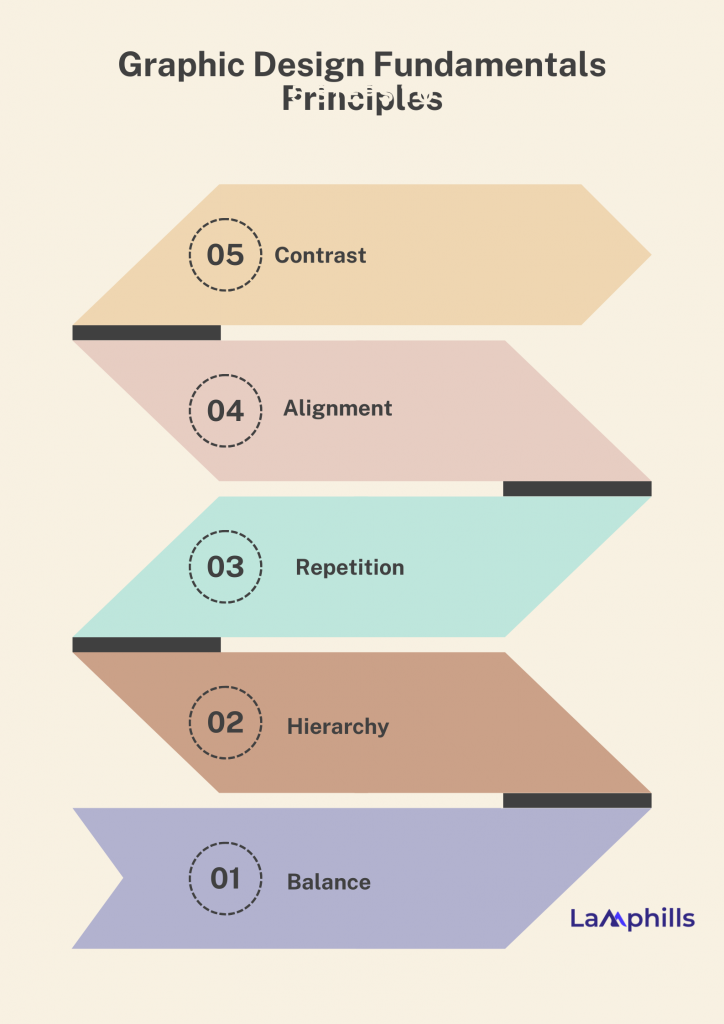If you’re interested in learning graphic design, I guess you already know how useful it can be. But trust me when I say that learning graphic design generally requires time, effort, continuous learning, and a lot of practice to become proficient, just like learning any new skill. I have been there, and it wasn’t so long ago because not much has changed in the last 5 months.
Seeing that I picked up this skill just recently and understand the stress that comes with it, I have put together what actions you can take to get started and key tips to help you navigate the process of understanding the fundamentals of graphic design.
Key Takeaways
- Graphic design fundamentals involve using typography, illustrations, and graphics to communicate ideas or concepts visually.
- The basic elements of graphic design include line, color, shape, size, texture, space, and typography.
- Key principles of graphic design are balance, hierarchy, repetition, alignment, and contrast, which help create visually appealing and effective designs.
- Learning graphic design software is crucial for designers, with options ranging from professional tools like Adobe Suite to free alternatives.
- Continuous learning and practice are essential for improving graphic design skills, including studying design theory and staying updated on industry trends.
What are Graphic Design Fundamentals?
If you’ve ever seen a logo, flyer, or social media advertisement that drew your attention and forced you to examine the design, you have experienced the potent visual communication that graphic design can generate.
This is what graphic design fundamentals help you achieve.
Graphic design fundamentals help communicate an idea or concept. Graphic designers use typography, illustrations, and graphics in their work. They employ a variety of design concepts and methods to communicate a certain message in a highly visible way.
And the best part? You don’t need a degree in graphic design to produce beautiful graphics. All you need to deliver a smooth user experience and convey a message through text or images is a basic comprehension of graphic design principles.
Basics of Graphic Design that all Newbies Should be Aware of
There are several ways to learn and practice graphic design if you’re just starting. The fundamentals of graphic design are the same whether you choose to learn through accredited programs and certifications or if you’d instead teach yourself using readily available guides and tools.
#1. Start With the Basics
Before experimenting with sophisticated software and practicing your initial concepts, it’s critical to grasp the principles. A foundational understanding of graphic design will enable you to build on your new ability.
Every newcomer should become familiar with the fundamentals of graphic design. These include alignment, color, contrast, space, proximity, hierarchy, repetition, and balance, among other important design concepts. Other essential elements of graphic design that designers must master are basic color theory and typography. Once you learn these foundational concepts and become acquainted with popular terms used in graphic design, you’ll have a solid foundation of knowledge that will support you in all future designs and projects.
#2. Learn How to Use Graphic Design Software
To generate their designs, you must be proficient with graphic design tools. However, there are other choices available, each with a different set of features, cost, and usability.
Numerous graphic design software solutions are available for every ability level, ranging from the well-known Adobe applications Illustrator, Photoshop, and InDesign to all-in-one tools like the CorelDRAW Graphics Suite or even free alternatives available online with limited features.
Make sure the option you choose has a good number of features, is affordable, and has lots of resources, such as tutorials and support pages, by comparing a few various options. When you first start using graphic design software, it can be very intimidating. To help you learn the ropes, you can find it very helpful to have access to FAQs, walkthroughs, or video tutorials.
#3. Keep Up Your Graphic Design Education
After you’ve mastered the fundamentals of graphic design and selected your software, it’s time to practice a lot. Over time, one of the best ways to enhance your talent and personal style is to practice often and consistently.
You can keep learning about graphic design by reading books, publications, or blogs dedicated to the subject. If you learn better with more hands-on approaches, you can also look into online tutorials, workshops, and courses. This can be a fantastic method to network with people in your sector and pick the brains of more experienced designers.
Graphic Design Fundamentals
Understanding the fundamental graphic design aspects included in every design project is a must for graphic designers.
Graphic design is based on seven fundamental principles:
#1. Line
One of the fundamental components of graphic design is the line which can be used to join two or more points. However, the main purposes of lines in graphic design are to divide space and draw the viewer’s attention to a particular area. Lines can be fat, thin, wavy, or any other shape you can think of when linking two places. Each style of line has a distinct feel.
Every graphic design project or image uses lines as graphic components, textures, patterns, and backdrops, so it’s easy to notice them there. It’s crucial to consider weight, texture, style, and color while working with lines because the variance in these elements might elicit distinct feelings or have a different visual impact on
#2. Color
Perhaps many people believe that color is a simple foundation of graphic design, but this is untrue because many colors don’t blend well together and might even convey opposing emotions. For this reason, it’s crucial to understand color theory and its meaning.
#3. Shape
One of the most fundamental components in graphic design is the shape.
Whether basic or complicated, geometric shapes provide a sense of control or order, giving the viewer a sense of naturalness.
The design relies heavily on shapes to convey concepts visually because of the way these shapes interact with one another. Looking at street signs and symbols will provide you with an easy way to see an illustration of this. It’s also common knowledge that forms in graphic design serve as the basis for many projects and aid in the arrangement and division of content from design work.
#4. Size
Larger items typically grab your attention more quickly than smaller ones. Size, also known as scale, is employed in design to make projects more dynamic and draw the viewer’s attention to certain areas of the composition.
You can use scale and size in forms, lines, fonts, and other design elements to add more variation to your composition and steer clear of dull designs.
#5. Texture
Since graphic design projects are primarily visual and cannot be handled physically (except package design), the elements must be perceived as they would be by the viewer. Textures are one way to achieve this. A surface’s texture is a physical attribute that can be mimicked in illustrations or other visual representations of the surface we wish to convey.
Because people can recognize some objects by their textures, they can tell how to touch them just by looking at them. For this reason, texture images are useful in graphic design. They allow the viewer to experience the tactile quality of an object without having to touch it.
Just a brief caution: don’t utilize too much texture in your design since it may distract the viewer.
#6. Space
Space is an essential visual feature that is frequently underappreciated. Many inexperienced graphic designers have “horror vacui” and steer clear of total blank space. Space is the region that surrounds the graphic components in a design project. It can be used as extra graphic elements by employing negative space to create concealed shapes, as shown in the FedEx Logo Design, or it can be used as a break for the eye to focus on other graphic elements in the composition.
#7. Typography
Typography is the final Basic Graphic Design element. Selecting the appropriate font for your design project is crucial since, similar to colors, different typographic styles evoke distinct feelings.
Typography comes in various styles: whimsical, serious, elegant, minimalistic, and many more. When working on a graphic design project, you must select a typeface that complements the idea you want your design to convey.
Using the design project template below saves time while decreasing the possibility of errors and miscommunication.
Design Project Templates.pdf
Graphic Design Fundamentals Principles
When discussing concepts used in graphic design, the phrases “principle” and “element” are sometimes used synonymously. However, there is a difference. The five fundamental graphic design elements are contrast, balance, repetition, hierarchy, and alignment. Let’s study these concepts a little bit more. Check out these infographics.

#1. Balance
Achieving balance and aesthetic stability within a design composition is the goal of balance. A balanced design produces an aesthetically pleasant and reassuring impression of harmony and order that puts the spectator at ease. To prevent any one element from dominating the others and to give the composition a sense of visual stability, designers should balance their elements.
#2. Hierarchy
Through the manipulation of hierarchy, designers can highlight specific features of the design, drawing attention to the most crucial components and detracting from less significant ones. In graphic design, hierarchy highlights specific elements of the design using rules like size, color, contrast, alignment, repetition, and brightness. Designers can demonstrate significance within the overall design by managing these aspects.
#3. Repetition
The intentional and regular reusing of particular design elements—like colors, forms, fonts, or visual patterns—across a creative effort is known as repetition. Through the use of repetition, designers establish a visual rhythm, uniformity, and consistency that aid in reinforcing important messages and directing the viewer’s attention. Repeated elements provide a design with a unified, polished appearance and support the main idea of the design.
#4. Alignment
The exact placement of items, including text, photos, and other visual components, concerning one another or to a predetermined grid pattern is known as alignment. When pieces are aligned properly, they are positioned in a way that complements the design’s overall structure and organization while still looking natural. It contributes to a neat and organized appearance, enhancing the design’s readability, clarity, and visual impact.
#5. Contrast
To establish differentiation and emphasis, contrast refers to the utilization of differences in visual elements, such as color, size, shape, or typography. Designers create visual impact, establish hierarchy, and direct the viewer’s attention to particular focal points by placing objects that have contrasting features next to each other. Contrast may enhance reading, highlight important information, and produce compositions that are memorable and exciting.
Here is a checklist to help you produce visually appealing and coherent compositions that successfully communicate their intended messages.
.
Graphic Design Principles Checklist.pdf
Can I learn graphic design on my own?
To work as a graphic designer, you don’t necessarily need a formal degree, but you do need to know the basics well. This entails familiarizing yourself with design fundamentals and understanding how to employ components such as color, contrast, hierarchy, balance, and proportion in your work with effectiveness.
Conclusion
In conclusion, I’ve shown you the fundamentals of graphic design in this article. You can now tell apart the finer points of any design project with ease. All you have to do now is combine all these design aspects to produce stunning graphic design projects!
Related Articles
- Best PPC Advertising Courses to Improve Your Digital Marketing Skills
- Top Digital Skills Examples That Will Make Your Resume Standout in 2024
- What Does a SEM Specialist Do? Job Description for 2024
- An Expert Guide to Mastering Local SEO: Best Practices for Local SEO Managers
- 10 Best SEO Reporting Tools I Have Used for Analytics and Performance Insights






